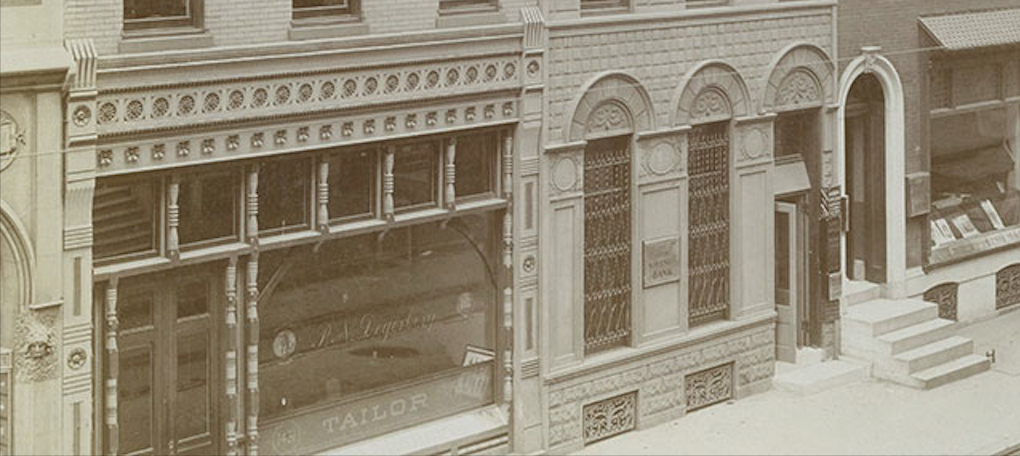Instead of meeting for class this week, I was assigned to visit either a place in Philadelphia my object was known to have been used or an archive containing documents pertaining to the life and activities of my object’s owner. Prior to my research this week, I knew that the owner and donor of the wool tweed tailored sports suit was Mrs. Stanley Bright and that the manufacturer was P.N. Degerberg. In order to situate my object in the context of local history, I had to learn more about both the suit’s manufacturer and owner. The first place I decided to visit this week was the Free Library of Philadelphia.
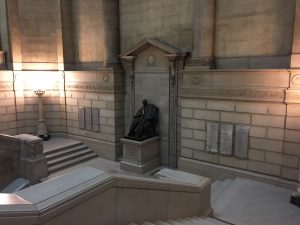
Statue of William Pepper, founder of the Free Library of Philadelphia.
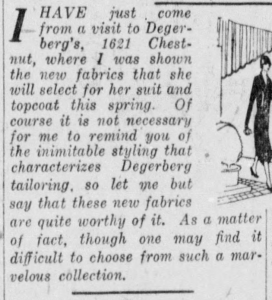
“March 3, 1927 (Page 4 of 32).” Philadelphia Inquirer (1860-1934), Mar 03, 1927.
While at the Free Library, I spent a good amount of time searching through the Philadelphia Inquirer archives and found a number of advertisements for P.N. Degerberg, such as the one pictured below. Based on what I read in the newspaper advertisements, Degerber Ladies Tailor had a prestigious reputation and was located on Chestnut Street, in the heart of the fashion industry in Philadelphia. It was not uncommon for me to find advertisements for competing tailors and clothing manufacturers located within a few blocks of one another. From what I know, P.N. Degerberg was not only a ladies’ tailor, but a prominent and seemingly wealthy Philadelphian who had the means to travel, was involved in a number of community events, served on a number of committees, and had an interest in the celebration of Swedish Heritage. I also found a number of help-wanted advertisements in which P.N. Degerberg was searching for highly skilled tailors. Based on the advertisements, Degerberg seemed willing to pay a generous wage and desired the highest quality of male workers. I also discovered that P.N. Degerberg moved from 1431 Chestnut to 1621 Chestnut, possibly soon after his death and change of ownership of the business to his two sons, Godfrey and George. It appears as if the sons had a desire to expand the business and had plans in 1913 to renovate 1621 Chestnut into a four story marble daylight building where they would do both men and womens’ tailoring. Thanks to some help from one of the librarians at the Free Library, I was able to locate a high resolution photograph of P.N. Degerberg at 1431 Chestnut Street.
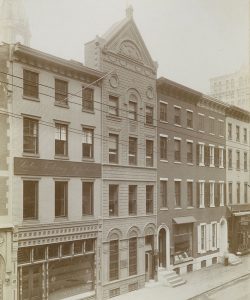
The building on the left is P.N. Degerberg Ladies’ Tailor at 1431 Chestnut Street. Taylor, Frank H. (Frank Hamilton), 1846-1927 – Photographer. Dime Savings Bank. Albumen Prints. Free Library of Philadelphia: Philadelphia, PA.
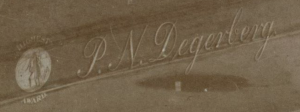
If you look closely, you can see that there is a label next to the name P.N. Degerberg that says, “highest award.” I found this by zooming in on a higher resolution version of the image shown above.
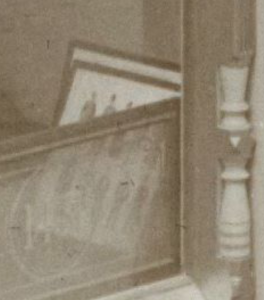
Zooming into the photo of P.N. Degerberg, you can see what appears to be some sketches of women wearing various outfits through the window.
After examining the photo of 1431 Chestnut Street, I decided to take a walk along Chestnut Street to see if the building was still there. Unfortunately, it has been replaced by a hotel. I also decided to walk to 1621 Chestnut, which also appears to have been replaced with a more modern building. So instead of focusing on specific buildings and architecture, I decided to focus on this section of Chestnut St. in general. I noticed that even today, this section of the street is filled with retail stores and is somewhat upscale. However the stores today are mass produced, unlike the highly customizable tailors of the early twentieth century.
While I was at the Free Library Earlier that day, I also wanted to start digging into the owner of the P.N. Degerberg suit and started searching for Mrs. Stanley Bright. Based on what I know about the quality and reputation of Degerberg’s work, I assumed that Mrs. Bright must have been fairly affluent to have been able to afford such a suit. I also came across an 1896 advertisement for a lost coat made by Degerberg. The finder is promised a $10 reward (almost $300 today). I can only wonder how much the woman paid for the coat with such a hefty reward.

Philadelphia Inquirer (Philadelphia, Pennsylvania) 134, no. 113, April 22, 1896: 10. Readex: America’s Historical Newspapers.
I also found a few different sites that credited items being donated by a Mrs. Stanley Bright. Check out this sofa and this artwork (all of these items, including the suit were donated in the 1950s). After doing a lot of digging, I found that Mr. Stanley Bright was the owner of Bright and Co. Wholesale Hardware in Reading, PA. It also seems that Stanley was a graduate of Princeton University after finding his name and mentions of his business in the Princeton Alumni Weekly. I also found records of Stanley and his wife (Sarah H. Gilpin) in the 1923 Social Register of Philadelphia, their address leading to Cedar Hill Farm in Reading, PA. After looking into Cedar Hill Farm, I found out that the property is now being used by Alvernia University as their President’s House.
I was also fortunate enough to find an article in Alvernia Magazine about the university’s acquisition of the property. According to the article, Mr. Stanley Bright and Mrs. Sarah Hood Gilpin Bright moved into the house in 1911 with their five children and transformed the property into a, “country manor.” The bright family hired Philadelphia architect R. Brognard Okie to expand and remodel the house. The article features several quotes from Sarah Bright and notes that the Bright family enjoyed traveling the world and spending time outdoors. I also found out that Sarah authored a number of articles on home decor published in home economics and womens’ magazines. I look forward to looking further into these articles as I continue to research.
Now that I have more information on Mrs. Stanley Bright, I have formulated a number of questions regarding local historical context.
- The Bright family seems to have been very wealthy and influential in the greater Philadelphia area. How does this wealthy family’s story compare to those of other influential Philadelphians? Was it common for people living in outlying towns to shop in Philadelphia? What did this say about their social and economic status?
- The donor records for Mrs. Bright’s suit mentions that it was worn at Lake Placid. Now that I know the family enjoyed traveling and being outdoors, I wonder what the Lake Placid experience would have been like. What types of activities were they doing? Was it popular for wealthy families to vacation at Lake Placid?
- How common was it for women to wear pants during this time? What practical purpose did they serve, if any? What does this new type of fashion say about femininity during the time?
